Setting attorney base salaries typically involves a complicated process for law firms. Law firms typically make salary decisions based on the following factors:
- What the competition is paying (using survey data and other market intelligence);
- Billable hours and economic contributions;
- The economic health of the firm
- Pay levels for other lawyers within the firm;
- Billing rates;
- Political factors;
- Subjective qualitative factors;
- Experience;
- Salary history; and
- Evaluation scores (assuming an evaluation process).
While all of these factors are legitimate, a more in-depth process also considers the qualitative factors outlined in our last post. We strongly encourage our clients to develop a written compensation and pay plan policy that covers:
- the factors considered in setting salaries,
- the weight given to each factor, and
- the timing of salary evaluations and adjustments.
Setting initial base salaries
For newly graduated or inexperienced lawyers, initial base salaries are mostly driven by market factors and sometimes unique factors related to a particular candidate. For example, an LLM or law school distinction may draw a starting salary uplift. In our experience, we have come across two basic approaches to setting salaries as indicated in the graphic below:
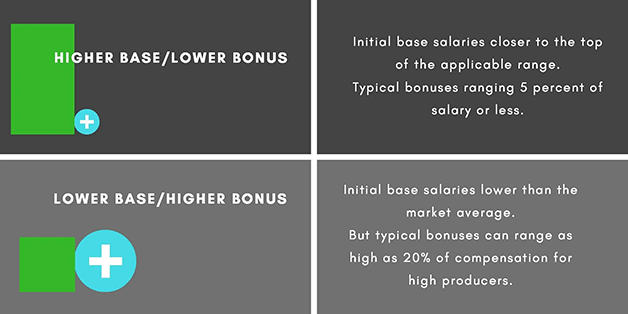
Firms with a higher risk tolerance tend to gravitate toward a higher base/lower bonus. Even though a lower base/higher bonus approach can lead to more income, candidates with strong credentials are often risk-averse and lean towards a higher base salary that is guaranteed. Candidates with more risk tolerance (which in our experience is fewer in number) may appreciate the increased earning opportunities associated with a strong bonus plan.
Beyond the risk component, some firms believe that a lower base salary with objective bonus targets will incent a higher level of productivity. In our experience, economic incentives can work when combined with adequate workload distribution processes. Alternatively, firms may prefer to use a higher base salary approach as a barrier to competitive firms poaching their people. Whichever approach a firm chooses to take, it is important to reconcile it with market factors, the firm’s economic structure, the availability of talent, and client requirements.
As mentioned previously, setting initial base salaries for inexperienced lawyers is heavily reliant on external factors. It is only after a couple of years that a firm can make an honest assessment of the qualitative factors that add to the long-term market value of a lawyer.
Adjusting base salaries for all lawyers
Firms that have a good track record of developing quality lawyers usually focus on the factors relating to “capability” in years 1-5 of a lawyer’s career. Capability refers to legal skills and practice area knowledge. Our experience teaches us that the foundational elements of a lawyer's career include quality of professional work, work ethic, and client relations and service.
Consider the following list of qualitative practice levels:
- Novice
- Intermediate
- Advanced
- Expert
Each firm must develop its own timetable for lawyers to attain these levels of competence and use them to inform salary decisions. For example - let's say a firm has a hard-working lawyer who produces a strong economic return but functions below the expected competency level - he may not earn a salary increase. In such an instance, a bonus for the economic contribution is more appropriate. In a later post, we will discuss progression policies and processes to ensure that lawyers progress to the appropriate competence levels.
Lockstep Approaches
Law firms sometimes default to lockstep systems for determining base salaries, especially for lawyers in the first 5-7 years of practice.
Essentially using a “pass-fail” approach to determine base salary increases, a lockstep approach gives salary increases commensurate with rank to those lawyers who have done enough to ward off negative conversation. Poorly performing lawyers do not advance. This yes/no approach fails to consider lawyers who may not warrant a full salary increase but have done enough to earn something. Since class year is the primary determinant of salary, lockstep approaches tend to have poor evaluation systems. It is easy to see why top performers feel frustrated and unmotivated under this approach.
To mitigate some of these negative aspects, a firm may use lockstep in recognition of differences in learning curves. The thought is that what is more important is the overall progression of the lawyer, not the lawyer's absolute place compared to their peers. Eventually, everyone catches up, or they are asked to leave.
We caution our clients who prefer lockstep systems to guard against mediocrity and to pay attention to the potential economic consequences. While a performance-based bonus program can mitigate these effects, it cannot substitute for an honest assessment of a lawyer’s qualitative factors and the likelihood of future advancement.
Balanced Approaches
Many law firms utilize hybrid methods to assess the overall value of a lawyer in setting his/her salary. While each firm values its attorneys’ contributions differently, economic contributions usually receive the most weight.
We advise our clients to separate the evaluation of base salaries from objective rewards for economic performance. Economic contributions can still have significant weight in the salary evaluation process, but as a qualitative criterion, which means other non-economic criteria also receive material weight.
For example, consider the following salary setting approach:
Assumptions:
- 10-year partner track
- Criteria and grading scale based on the firm’s culture, experience, strategic needs, client needs, and financial model
- Criteria are evenly considered using the indicated point scale
- Composite economic score counts as 1 criterion in the qualitative evaluation
- Market influences, candidate qualifications, and the firm’s internal salary structure inform starting salary levels
- The firm uses banded salary ranges with a floor and ceiling level based on experience
- The firm also rewards economic contributions through a bonus program
The tables below indicate the relevant criteria and performance weight in the base salary consideration. Objective data typically exists for all economic factors, which can significantly reduce subjective interpretations.
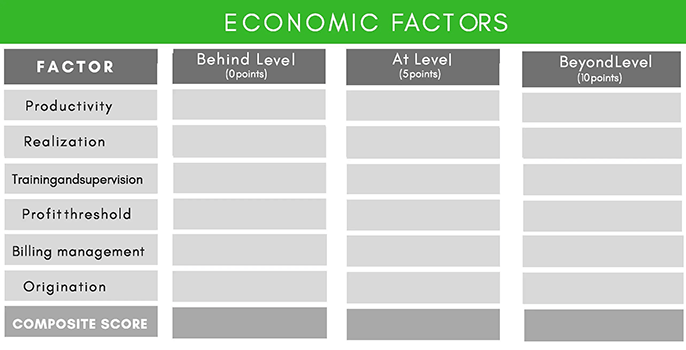
Assessing qualitative contributions (see the table below) requires subjective and objective methods. For example, work quality and work ethic will rely heavily on input from the supervising partners or attorneys. Contributions in the other qualitative areas are easy enough to assess. And while it will take more effort to create metrics to rate client relations and service, it can not only pay huge dividends but also help focus attorneys on the most important aspects of a client relationship.
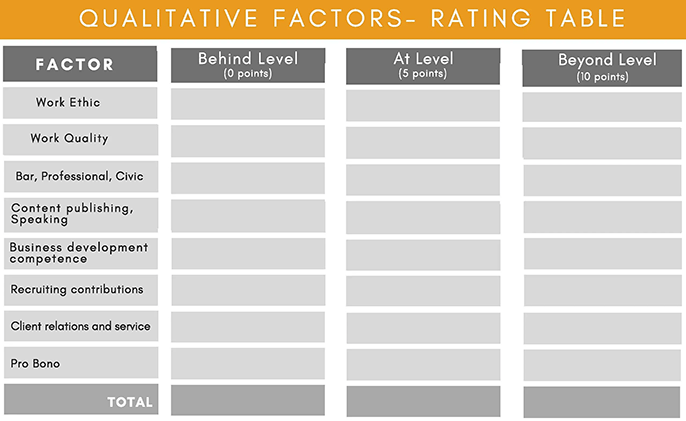
To ensure that the importance of each factor is communicated, a firm can create guidelines. For example, the table below indicates expectations by experience level. It is possible to generate objective data about all of the factors indicated in the table below.
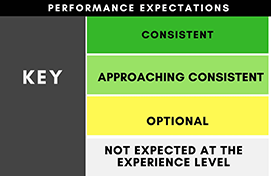
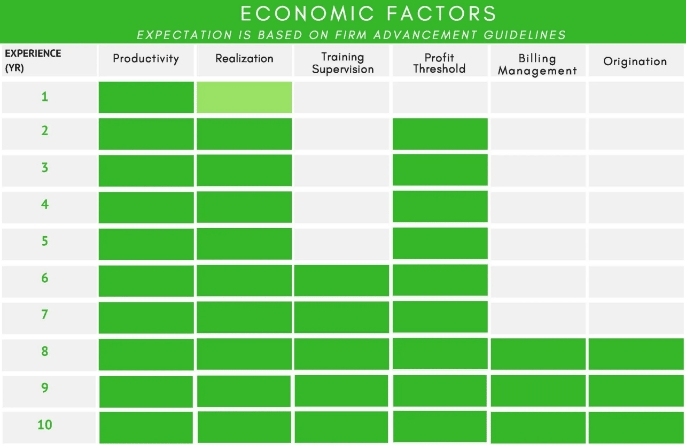
A firm may decide to combine all economic scores and consider the aggregate result as a qualitative factor.
As long as the selected system is consistently applied, room exists for a liberal amount of customization.
.webp?width=686&name=QualitativeFactorGuideline_%20(1).webp)
Valuing one factor over another will differ from firm to firm. Most importantly is for a law firm to clearly define the skill set they believe brings repeatable, long-term value to the firm -- and then compensate lawyers accordingly. This will help ensure that a firm’s best-fit people stay long enough to realize their potential.
Law firms can award lawyers who function beyond their years in high-value categories (ex. work ethic, work quality, client service) by moving them into higher salary bands and even awarding qualitative bonuses. This tactic encourages lawyers to continue to perform at a high level.
Firms that approach attorney compensation in this way recognize the creation of long-term value and organizational fit. For example, a litigation firm that has a long-term need for litigators may reward successful trial experience. A firm may also award bonuses for recognizable qualitative accomplishments that do not necessarily translate into repeatable value for the lawyer (skills that can serve the firm’s clients) but did contribute to the mission of the firm. For example, a lawyer may be awarded a bonus for chairing the firm’s summer associate program. Assuming satisfactory financial performance, fairness dictates monetary recognition for these contributions, but not necessarily base salary increases.
TO NOTE
Trying to separate fact from perception is difficult. Partners can sometimes advance the attorneys they personally like and overlook others who fit better into the firm’s practice needs. To ensure that the firm identifies and invests in the right lawyers, we recommend a structured process. When law firms carefully define compensation criteria and apply objective data to compensation decisions, they can reduce many of the personal and emotional aspects often tied to the compensation process.
When law firms carefully define compensation criteria and apply objective data to compensation decisions, they can reduce many of the personal and emotional aspects often tied to the compensation process.
See the following recap of results based on the previously identified work quality grades, client service metrics, and activity scores.
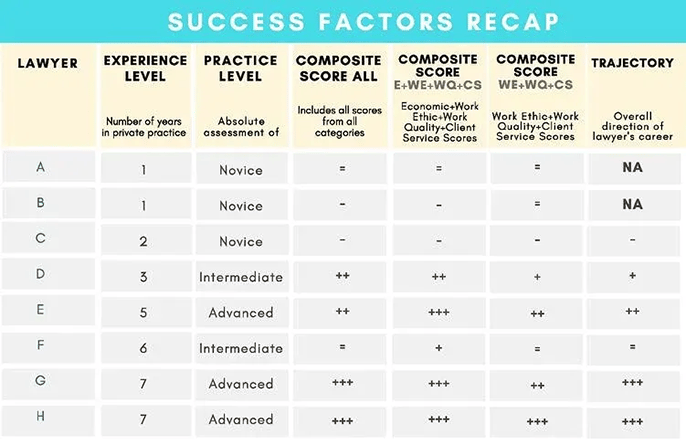
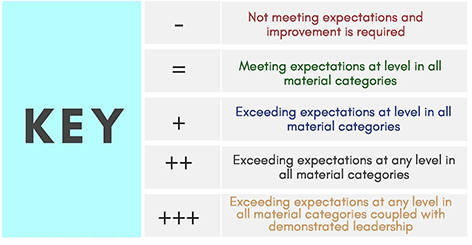
PUTTING IT ALL TOGETHER
Law firms can make informed attorney compensation decisions when they use a combination of the following: the success factors recap, market factors, strategic considerations, and the firm’s economic capabilities. To ensure that the firm’s highest-rated performers receive adequate consideration, we suggest working from top to bottom.
Too often, an inordinate amount of valuable time is spent discussing underperformers, which can result in overlooking the full value of high performers.
An effective salary administration process requires an efficient data collection system. This administrative system should reduce the burden on partners and also produce through objective data. While it is possible to create procedures to collect objective data in almost any important area, the following list indicates the most common factors :
- Work Quality
- Financial Contributions (all areas)
- Bar, Professional and Civic Contributions
- Work quality (assignment tracking)
- Content creation, publishing, and speaking
- Business development competence
- Recruiting contributions
- Client relations and service
- Pro Bono
Smaller firms can abbreviate this process but still must pay attention to all of the important success factors, market forces, strategic factors, and economic capability.
Profitability Methods
Since it usually takes time for young lawyers to generate enough collectible billings to meet the firm’s profit expectations, law firms should apply profitability methods to set compensation for senior lawyers (8 + years), or once lawyers have reached a state of constancy in their career. Targeted profitability models can also work well in lateral situations.
Consider the following example:
|
|
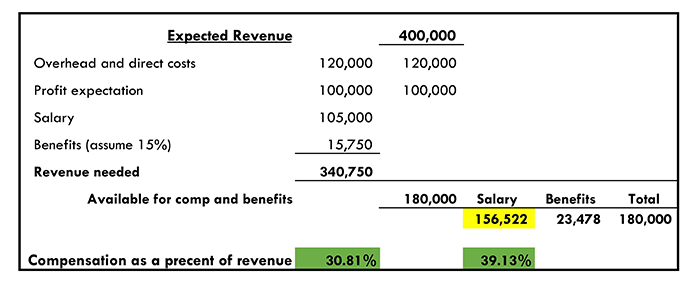
In this simple example that assumes profit expectations don’t scale, compensation can range from approximately 30% to 40% of gross revenue. Firms paying guaranteed base salaries take the risk of performance in any given year, and many firms prefer a conservative base salary approach coupled with a better bonus opportunity. Replacing guaranteed base salaries is also a common practice in targeted profitability models.
Using profitability to set compensation can require consideration of several other factors including:
- Scaling profit expectations to account for unique situations
- Rate differentials not related to work complexity
- Strategic client work that is less profitable
- Pricing structures that restrict partner top rates in lieu of better associate rates
- The risk components related to salary guarantees versus adjustable draws
- Contingent fee cases
- Overhead allocation policies
Given the risk-reward nature of salaries determined by using a law firm profitability model, we recommend setting base salaries or draws at the lower end and offering a corresponding objective bonus compensation tied to the achievement of revenue or profit goals. Finally, compensation based on profitability works best for firms with efficient cost structures.
Role Players and Salary Caps
It is not unusual to encounter firms that compensate role players with a guaranteed base salary that reflects a limited bonus opportunity. For example, certain types of client work require a certain level of training and expertise, and once achieved, results in minimal variation in results year over year. Typical characteristics of these practice types include steady demand, a stable workforce, a limited rate of revenue growth, and limited upward mobility. In these instances, a commensurate base salary, and a simple billable incentive will likely suffice.
When salary caps occur, a firm has essentially reached a maximum level of acceptable risk. Managing salary caps without an accompanying bonus program can reduce the incentive to perform. It is not unusual to see performance decline in the absence of incentives or consequences. Becoming comfortable or resigned to a compensation level can begin a negative cycle and result in serious performance situations.
Summing it up
Setting base salaries is inherently a judgment call, but law firms must use every available tool to ensure that compensation is market competitive, is fair, and rewarding the right behaviors. Firms must also ensure that their cost structure, workload distribution, systems, and processes all afford attorneys ample opportunity to progress and practice profitably.
.webp?width=124&height=108&name=PerformLaw_Logo_Experts3%20(1).webp)

